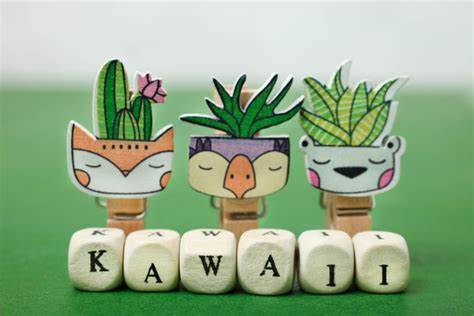Kawaii, a Japanese term that translates to “cute” in English, has become a significant and influential aspect of visual culture worldwide. From adorable characters in anime to charming designs in everyday products, kawaii culture permeates many facets of life, both in Japan and across the globe. This article explores the concept of kawaii, its impact on visual culture, and why kawaii pictures have become so popular.
What is Kawaii Culture?
Kawaii culture originated in Japan and is deeply rooted in the country’s history and aesthetics. The term “kawaii” first emerged in the 1970s, largely influenced by the growing popularity of cute handwriting and cartoon characters among young girls. This phenomenon quickly spread beyond Japan, becoming a global trend.
- Historical Roots: Kawaii culture can trace its roots back to Japan’s Edo period, where the aesthetics of cuteness began to emerge in art and fashion. However, it wasn’t until the 20th century, with the rise of consumer culture, that kawaii truly blossomed into the cultural phenomenon it is today.
- Global Influence: While kawaii started in Japan, it has since influenced global fashion, art, and design. The appeal of kawaii lies in its ability to evoke positive emotions, making it universally attractive.
Why Are Kawaii Pictures So Popular?
Kawaii pictures, featuring everything from chubby animals to wide-eyed characters, have captivated audiences worldwide. But what makes these images so appealing?
- Psychological Appeal: Kawaii pictures tap into a psychological response known as “baby schema,” where features like large eyes, small noses, and round faces trigger nurturing instincts. This response is hardwired into humans, making us naturally drawn to cute images.
- Emotional Connection: Kawaii pictures often evoke feelings of warmth, comfort, and happiness. In a world that can be stressful and chaotic, these images provide a sense of relief and joy, making them highly sought after.
- Versatility: The versatility of kawaii images allows them to be used in various contexts, from advertising and social media to product packaging and home decor. This widespread use further amplifies their popularity.
How Has Kawaii Influenced Visual Culture?
Kawaii has had a profound impact on visual culture, shaping the way we perceive and create images. This influence can be seen across various mediums, including fashion, design, and digital media.
- Fashion: Kawaii fashion, characterized by bright colors, playful patterns, and childlike accessories, has become a global trend. From Harajuku street style to Western fashion brands, the influence of kawaii is evident in clothing and accessories that prioritize cuteness.
- Graphic Design: In graphic design, kawaii aesthetics are used to create appealing visuals that attract attention and evoke positive emotions. The use of pastel colors, simple shapes, and exaggerated features is common in kawaii-inspired designs.
- Social Media: On social media platforms like Instagram and Pinterest, kawaii pictures are widely shared and celebrated. These platforms have become a hub for kawaii culture, where users can express their love for all things cute through images and artwork.
What Are Some Iconic Kawaii Characters?
Certain characters have become synonymous with kawaii culture, representing the pinnacle of cuteness in visual media. Here are some of the most iconic kawaii characters:
- Hello Kitty: Perhaps the most recognizable kawaii character, Hello Kitty was created by Sanrio in 1974. With her simple design and lack of a mouth, Hello Kitty has become a global symbol of kawaii culture.
- Pikachu: The beloved Pokémon character Pikachu, with its round body and expressive eyes, is another example of kawaii design that has achieved worldwide fame.
- Totoro: From Studio Ghibli’s “My Neighbor Totoro,” Totoro is a giant, cuddly creature that embodies the essence of kawaii with its gentle demeanor and childlike innocence.
- Rilakkuma: A more recent addition to the kawaii canon, Rilakkuma is a laid-back bear character who enjoys lounging around. His relaxed attitude and simple design have made him a favorite among kawaii enthusiasts.
How Can You Create Kawaii Pictures?
Creating kawaii pictures involves more than just drawing something cute; it requires an understanding of the aesthetics and principles that define kawaii. Here are some tips for creating your own kawaii images:
- Use Simple Shapes: Kawaii designs often rely on simple, rounded shapes that are easy to recognize and pleasing to the eye. Avoid sharp angles and complex forms, opting instead for soft, gentle lines.
- Focus on Proportions: The proportions of kawaii characters are typically exaggerated, with large heads, big eyes, and small bodies. This creates a sense of innocence and playfulness that is central to kawaii aesthetics.
- Choose Soft Colors: Pastel colors are a staple of kawaii design. Use soft pinks, blues, and yellows to create a soothing and gentle palette that enhances the cuteness of your image.
- Express Emotion: Kawaii characters often have simple but expressive faces. A small smile, a pair of wide eyes, or a blush can convey a lot of emotion, making the character more relatable and endearing.
- Add Whimsical Details: Little details like bows, stars, or hearts can add an extra layer of cuteness to your design. These elements should be subtle but effective in enhancing the overall kawaii feel.
Why is Kawaii Culture Important in Japan?
In Japan, kawaii culture is more than just a trend; it’s a significant part of the national identity and cultural expression.
- Cultural Significance: Kawaii culture reflects Japan’s values of harmony, gentleness, and respect for innocence. It’s a way for people to express themselves in a society that often values conformity and restraint.
- Economic Impact: The kawaii industry is a major economic force in Japan, driving sales in fashion, toys, media, and more. Brands like Sanrio and Pokémon have built entire empires around kawaii characters, contributing significantly to the economy.
- Social Impact: Kawaii culture also has a social impact, providing a means of connection and communication. In Japan, it’s common to see kawaii characters used in advertising, public service announcements, and even government campaigns, making important messages more approachable and engaging.
Conclusion:
Kawaii pictures are more than just cute images; they represent a cultural phenomenon that has captivated hearts worldwide. Whether it’s the psychological appeal of baby-like features, the emotional connection to innocence, or the broad influence on visual culture, kawaii has become an integral part of how we experience and create art.
As kawaii culture continues to evolve, it’s clear that the art of cuteness will remain a powerful force in visual media. Whether you’re an artist looking to create kawaii images or simply someone who appreciates the charm of kawaii, there’s no denying the impact and importance of this unique aesthetic.







